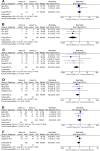Video laryngoscopy versus direct laryngoscopy in achieving successful emergency endotracheal intubations: a systematic review and meta-analysis of randomized controlled trials
- PMID: 38475918
- PMCID: PMC10935931
- DOI: 10.1186/s13643-024-02500-9
Video laryngoscopy versus direct laryngoscopy in achieving successful emergency endotracheal intubations: a systematic review and meta-analysis of randomized controlled trials
Abstract
Background: Intubating a patient in an emergent setting presents significant challenges compared to planned intubation in an operating room. This study aims to compare video laryngoscopy versus direct laryngoscopy in achieving successful endotracheal intubation on the first attempt in emergency intubations, irrespective of the clinical setting.
Methods: We systematically searched PubMed, Scopus, Web of Science, and the Cochrane Central Register of Controlled Trials from inception until 27 February 2023. We included only randomized controlled trials that included patients who had undergone emergent endotracheal intubation for any indication, regardless of the clinical setting. We used the Cochrane risk-of-bias assessment tool 2 (ROB2) to assess the included studies. We used the mean difference (MD) and risk ratio (RR), with the corresponding 95% confidence interval (CI), to pool the continuous and dichotomous variables, respectively.
Results: Fourteen studies were included with a total of 2470 patients. The overall analysis favored video laryngoscopy over direct laryngoscopy in first-attempt success rate (RR = 1.09, 95% CI [1.02, 1.18], P = 0.02), first-attempt intubation time (MD = - 6.92, 95% CI [- 12.86, - 0.99], P = 0.02), intubation difficulty score (MD = - 0.62, 95% CI [- 0.86, - 0.37], P < 0.001), peri-intubation percentage of glottis opening (MD = 24.91, 95% CI [11.18, 38.64], P < 0.001), upper airway injuries (RR = 0.15, 95% CI [0.04, 0.56], P = 0.005), and esophageal intubation (RR = 0.37, 95% CI [0.15, 0.94], P = 0.04). However, no difference between the two groups was found regarding the overall intubation success rate (P > 0.05).
Conclusion: In emergency intubations, video laryngoscopy is preferred to direct laryngoscopy in achieving successful intubation on the first attempt and was associated with a lower incidence of complications.
Keywords: Direct laryngoscope; Emergent airway; Emergent intubation; Endotracheal intubation; First-attempt success; Video laryngoscopy.
© 2024. The Author(s).
Conflict of interest statement
The authors declare that they have no competing interests.
Figures





Similar articles
-
Video laryngoscopy may improve the intubation outcomes in critically ill patients: a systematic review and meta-analysis of randomised controlled trials.Emerg Med J. 2025 Apr 22;42(5):334-342. doi: 10.1136/emermed-2023-213860. Emerg Med J. 2025. PMID: 39358006 Free PMC article.
-
Videolaryngoscopy versus direct laryngoscopy for tracheal intubation in neonates.Cochrane Database Syst Rev. 2023 May 12;5(5):CD009975. doi: 10.1002/14651858.CD009975.pub4. Cochrane Database Syst Rev. 2023. PMID: 37171122 Free PMC article. Review.
-
A comparison between video laryngoscopy and direct laryngoscopy for endotracheal intubation in the emergency department: A meta-analysis of randomized controlled trials.J Clin Anesth. 2018 Jun;47:21-26. doi: 10.1016/j.jclinane.2018.03.006. Epub 2018 Mar 14. J Clin Anesth. 2018. PMID: 29549828
-
Direct Laryngoscopy Versus Video Laryngoscopy for Intubation in Critically Ill Patients: A Systematic Review, Meta-Analysis, and Trial Sequential Analysis of Randomized Trials.Crit Care Med. 2024 Nov 1;52(11):1674-1685. doi: 10.1097/CCM.0000000000006402. Epub 2024 Sep 18. Crit Care Med. 2024. PMID: 39292762
-
Efficacy of bougie first approach for endotracheal intubation with video laryngoscopy during continuous chest compression: a randomized crossover manikin trial.BMC Anesthesiol. 2024 May 21;24(1):181. doi: 10.1186/s12871-024-02560-3. BMC Anesthesiol. 2024. PMID: 38773386 Free PMC article. Clinical Trial.
Cited by
-
Airway Management in Otolaryngology and Head and Neck Surgery: A Narrative Review of Current Techniques and Considerations.J Clin Med. 2025 Jul 3;14(13):4717. doi: 10.3390/jcm14134717. J Clin Med. 2025. PMID: 40649091 Free PMC article. Review.
-
A Better Standard to Assess the Performance of Portable Suction Devices: Time-Averaged Air Flow Rate.Ann Biomed Eng. 2025 Jul 10. doi: 10.1007/s10439-025-03764-5. Online ahead of print. Ann Biomed Eng. 2025. PMID: 40634625
-
Comparison of Macintosh Direct Laryngoscope with the C-MAC and Tuoren Videolaryngoscopes in Facilitating Endotracheal Intubation during Uninterrupted Manual Chest Compression: A Randomized Crossover Manikin Study.Indian J Crit Care Med. 2025 Feb;29(2):113-116. doi: 10.5005/jp-journals-10071-24897. Epub 2025 Jan 31. Indian J Crit Care Med. 2025. PMID: 40110158 Free PMC article.
-
Field-Ready Suction Solutions for Emergencies: The Battlefield Ready Innovative Suction Kit (BRISK).Ann Biomed Eng. 2025 Jun;53(6):1409-1422. doi: 10.1007/s10439-025-03700-7. Epub 2025 Mar 28. Ann Biomed Eng. 2025. PMID: 40153195
References
-
- Mort TC. Emergency tracheal intubation: complications associated with repeated laryngoscopic attempts. Anesth Analg. 2004;99(2):607–13, table of contents. 10.1213/01.ane.0000131494.00339. (98.3%). - PubMed
Publication types
MeSH terms
LinkOut - more resources
Full Text Sources

